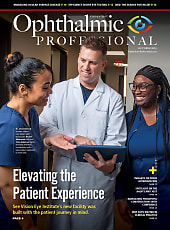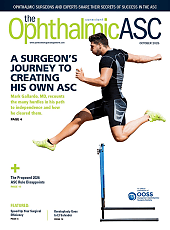In a new longitudinal cohort study, researchers at University of Colorado School of Medicine have identified several systemic complement factors that are significantly associated with the progression from intermediate age-related macular degeneration (iAMD) to its advanced stages—geographic atrophy (GA) and neovascular AMD (nAMD). There may be a potential role for systemic biomarkers in risk stratification and early intervention in patients with iAMD.
The investigators tracked 325 patients who were diagnosed with iAMD from 2014 to 2022, using data from the University of Colorado AMD registry. Patients underwent annual multimodal imaging and plasma sampling. Cohort participants were a mean age of 76 years (65% female). Over a mean follow-up of 3.9 years, 110 patients (34%) progressed to advanced AMD. Sixty-four cases progressed to GA (20%) and 46 progressed to nAMD (14%).
The researchers then analyzed the relationship between 25 systemic complement factors/ratios and the time to progression to advanced AMD using joint modeling techniques. “Early genome wide association studies and subsequent functional studies have identified that genetic variants in certain complement components, such as C3, factor H, factor B, and factor I, contribute to AMD development by increasing complement system effects through lowering the threshold for initiation or increasing the activation rate,” the study authors explained in their JAMA Ophthalmology article.
The significant biomarkers that were associated with an increased hazard of progression to any advanced AMD included:
- C4: hazard ratio (HR) = 6.8 (95% credible interval [CrI] = 1.7–26.2; FDR-adjusted P=.03)
- C4b: HR = 60.4 (95% CrI = 6.5–543.8; FDR-adjusted P<.001)
- C3a/C3 ratio: HR = 49.4 (95% CrI = 5.2–675.3; FDR-adjusted P<.001)
- C5a/C5 ratio: HR = 29.3 (95% CrI = 4.8–258.1; FDR-adjusted P<.001)
- sC5b-9/C5 ratio: HR = 296.7 (95% CrI = 10.0–14,877; FDR-adjusted P=.003)
- Factor I: HR = 525.9 (95% CrI = 5.5–107,589; FDR-adjusted P=.02)
Notably, lower systemic levels of C3 and C5 were also strongly associated with disease progression. This finding suggested consumption during activation.
When the researchers examined competing risks, C3a/C3 and C5a/C5 ratios were significantly associated with progression to GA:
- C3a/C3: HR = 9.5 (95% CrI = 1.9–55.9)
- C5a/C5: HR = 28.6 (95% CrI = 5.7–157.9)
No complement factor reached statistical significance for association with progression to nAMD.
Time-dependent receiver operating characteristic analysis using 24-month biomarker data showed moderate to good discrimination between progressors and nonprogressors:
- C3a/C3: time-dependent area under the curve (tdAUC) = 0.75
- C5a/C5: tdAUC = 0.69
- sC5b-9/C5: tdAUC = 0.71
- Combined C3a/C3 + sC5b-9/C5: tdAUC = 0.76
These results suggest that a subset of complement biomarkers may have clinical utility in identifying iAMD patients who are at elevated risk for progression.
“This longitudinal study also resulted in the finding of a relationship between select components of the classical pathway, underexplored in clinical AMD research, with time to progression to any advanced AMD,” the authors wrote. This finding, along with others from previous research, “suggest that the classical pathway should receive more attention in the study of AMD pathogenesis because activation of this pathway may be an important driver of the downstream effect of uncontrolled complement activation that potentially may influence iAMD progression,” they added.
Complement dysregulation, which has been long implicated in AMD pathogenesis, may serve not only as a marker of risk but also as a potential therapeutic target. The findings of this study are particularly relevant considering the recently approved intravitreal complement inhibitors for GA— pegcetacoplan (Syfovre; Apellis) which targets C3/C3b and avacincaptad pegol (Izervay; Astellas) which targets C5, the authors noted.
While the study provides robust evidence for complement involvement in AMD progression, limitations include sample attrition, undetermined exact progression timing, and limited statistical power for distinguishing between GA and nAMD outcomes. The research team’s future analyses will explore the interaction of complement biomarkers with genetic polymorphisms and retinal imaging features.
They concluded, “The study’s findings do not necessarily change the monitoring or outcomes of individuals with iAMD. However, the discovery of biomarkers of more rapid progression would allow for the introduction of new bioassays into future clinical trials to identify patients with iAMD who may benefit from specific therapeutics. Moreover, the biomarkers identified may lead to the discovery of the biologic pathways involved in the onset and progression of AMD, which may open the door for new therapies to prevent or slow the progression of the disease.”
A full list of author disclosures can be found in the original publication. RP








